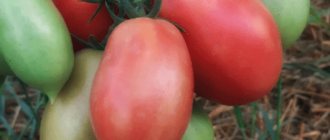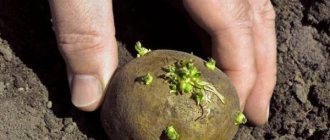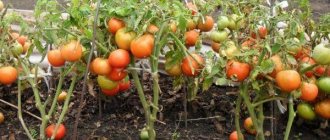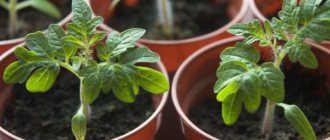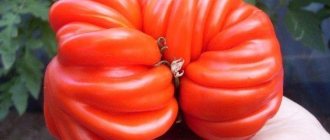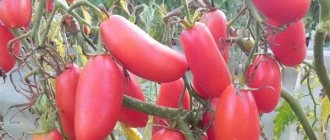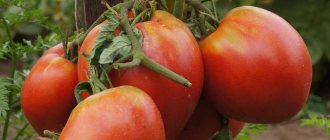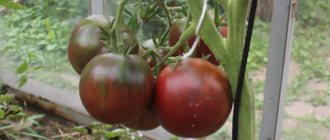Description of the Lyubasha hybrid
The ultra-early hybrid Lyubasha was bred by selection relatively recently - in 2016, and a year later it was officially included in the state register of Russia and recommended for cultivation in all regions, both in protected and unprotected soil.
The tomato is characterized by a fairly short vegetative ripening period - 65-75 days after sowing the seeds. It belongs to the group of standard determinant hybrids, which indicates that the growth of its bush is limited when it reaches a meter in height.
Bushes
The average height of adult bushes is from 60 to 100 cm, and therefore they must be pinched and tied to supports. The bushes grow in a regular shape with strong stems that can withstand a lot of weight during the ripening of the crop. Each bush has about 4-5 brushes. The leaves are bright green and small in size.
Fruit
Tomatoes grow medium in size, have a regular round shape and a bright red color. The weight of the fruit is about 120-150 g. The peel is smooth, glossy, the flesh is dense, due to which tomatoes of this variety do not crack, have a marketable appearance and can withstand transportation well over long distances. The fruit is juicy, quite fleshy and has a delicate taste. The fruits contain a moderate number of seeds, seed nests - 3-4 pieces.
Features of the variety, pros and cons
A characteristic feature of the Lyubasha hybrid is that in one internode it is possible to form two inflorescences, both of which will produce full-fledged tomatoes in all clusters. This property will not affect the taste of the fruit and will not in any way interfere with the formation of fruit clusters in the remaining internodes.
Advantages:
- Ultra-early simultaneous ripening of all fruits, which is of great importance when growing tomatoes for sale.
- Possibility of growing both in unprotected soil and in a greenhouse.
- High yield.
- Resistance to blossom end rot and tolerance to Alternaria blight, late blight and tobacco mosaic virus - the main diseases that actively affect other tomato varieties.
- Easy to care for.
- Excellent taste and convenient fruit size, as a result of which Lyubasha F1 tomatoes can be consumed both fresh, processed and canned.
Flaws:
- Poor tolerance to low temperatures.
- The need for regular loosening of the soil, as well as fertilizing, which requires constant presence on the site.
- Simultaneous ripening of the fruits will not allow them to be eaten fresh throughout the season.
The features and advantages of the hybrid ultra-early tomato Lyubasha are described in detail in the presented video:
The nuances of growing in open ground and in a greenhouse
The culture is equally well adapted to open ground and to the greenhouse. But in protected soil the yield is higher.
Growing in a greenhouse leads to waterlogging, which is manifested by a surge in fungal diseases. To avoid this, ventilate the greenhouse regularly. But remember that tomatoes do not like drafts.
Outdoors, for tomato beds, choose a sunny place, open, but protected from strong winds. A slight breeze will prevent fungal spores from settling. In open ground, the greatest likelihood of attacks by insect pests remains, with the exception of spider mites, which prefer greenhouse conditions. Therefore, if the variety is planted outside, the main preventive measures are to protect the beds from insects.
Agrotechnical measures
In order to achieve the maximum effect from growing the Lyubasha hybrid with minimal effort, time and money, you should first become familiar with the correct technology of agrotechnical measures.
Growing seedlings
The timing of sowing Lyubasha F1 tomato seeds depends on the climate zone and usually occurs in mid-February - early March. It is also possible to calculate based on the fact that transplantation into open ground is carried out 50 days after the appearance of the first shoots. A necessary condition is the absence of night frosts. Seeds should be planted in a pre-prepared soil mixture, which includes:
- Loose soil, disinfected from pests. For this purpose, it is recommended to dry it in the oven for 40 minutes.
- Lowland peat.
- Humus.
- Rotted manure.
For planting seedlings, any container in which you can plant seeds in a row (wooden boxes, plastic containers with pre-made holes to drain excess water) is suitable. Seedlings are practically not demanding in terms of lighting, humidity and temperature conditions. It can even be grown in an apartment (preferably on the south side) using additional lighting.
Tomato seeds are planted in a row, and the distance between them should be at least 3-4 cm. The depth of the holes is about 1 cm. After that, the soil is watered, covered with cling film, and the containers with seedlings are transferred to a warm place.
To avoid rapid overheating of the soil, it is not recommended to place containers on radiators.
Caring for seedlings of the Lyubasha hybrid is standard. The light period is at least 12 hours a day. Temperature in the room: in the first week – no more than +23÷+25°С, in the second week – +20°С. Watering is carried out as the soil dries: the first three weeks - every 6-7 days, then - 4-5 days. Under no circumstances should the soil be over-watered, otherwise the seedlings may die.
At the stage of growing seedlings, the soil does not need to be fed. However, if there are doubts about its quality, it is recommended to apply a complex fertilizer containing phosphorus, potassium and magnesium in the first week. Then fertilizing is done when three leaves have already formed on the stem. In this case, fertilizers rich in nitrogen and potassium are applied.
Transplanting seedlings into a greenhouse or open ground
The first step is to prepare holes for planting seedlings at a distance of 50 cm from each other. After that, they are filled with water and humus is poured into each, mixed with mineral fertilizers.
Before removing seedlings from containers, the soil should be moistened to prevent possible damage to the roots and to easily release the seedlings from the container. In order to properly grab the bushes, you need to carefully grab their trunk and slowly remove the plant from the soil. Next, the bush is installed vertically in the hole and sprinkled with compost. Then you should mulch the soil using sawdust, straw or grass clippings.
Caring for Lyubasha tomatoes
Formation of bushes. In order to obtain the most generous harvest, the manufacturer recommends forming Lyubasha hybrid bushes into 2-3 stems, which depends on the frequency of planting. If per 1 sq. m of soil, no more than four plants are planted, formation is carried out in 3 stems. To do this, you should leave two stepsons that grow above and below the first flower cluster.
With a denser planting, it is preferable to leave only two stems on the hybrid bushes - the main and secondary ones from the bottom of the first flower cluster. The remaining side shoots must be removed as they appear. Despite the fact that the bushes are medium-sized, it is recommended to tie them to supports, since the harvest puts a lot of stress on them, as a result of which the tomatoes may sink to the ground. The stems, in turn, become very thick, even thicker than the stakes to which they are tied.
Watering. Watering is carried out mainly in the evening with a frequency of one (spring and early summer) to several (mid-summer) days a week.
Experts recommend watering the plant at the root so as not to disturb the growth of the bushes.
After watering, it is advisable to loosen the soil and weed it out of weeds.
Feeding . Fertilizers are first applied two weeks after planting the seedlings. Then the soil should be fed every ten days. Mullein, mineral fertilizers and chicken droppings can be used as fertilizing. Throughout the growing season, tomato bushes should be re-fed - sprayed with preparations of effective microorganisms (EM), as well as a solution of wood ash.
REVIEWS OF GARDENERS
Since the Lyubasha hybrid appeared on the Russian market quite recently - almost a year ago, there are not many reviews on it yet. But even those that exist give us hope that this tomato is very promising and reliable for planting in the most unpredictable conditions.
Alena, 38 years old, Orel
We read about the emergence of a new hybrid and decided, together with our friends, to purchase seeds of different varieties, including Lyubasha. The weather this year was not tomato-like at all - cold, rainy, and then the heat came. But, interestingly, almost all the bushes were affected by late blight, only Lyubasha survived. True, we processed everything with Em-kami, so our tomatoes still ripened and other varieties too, but still Lyubasha amazed me with her durability, yield, and taste. We made so many delicious things out of tomatoes for the winter - now we will remember about it in winter too. The only pity is that she is a hybrid, it is useless to leave her for seeds, nothing good will grow anyway.
Victor, 44 years old, Tambov
I bought seeds in a store and the sellers advised me to try a new variety of tomatoes that ripens earlier than others. I have a large greenhouse, but I decided to divide the grown seedlings and planted 10 bushes under polycarbonate and 10 bushes in open ground. At first the bushes developed very well, but then I had to leave for a couple of weeks and all this time it rained in an endless stream. By the time we arrived, all the tomato bushes in the open ground had turned black from late blight. But we still decided to try to cure them with EM drugs. Some of the harvest was saved, but the difference was big. In the greenhouse, almost five kilograms of wonderful, tasty tomatoes were collected from each bush. Well, there was still a harvest in the beds, but half as much and several weeks later. Despite the fact that instead of fertilizing, I just planted them initially in humus-rich soil and that’s it.
Harvesting tomato Lyubasha
Harvesting depends on climatic conditions, frequency and composition of fertilizing. As a rule, it begins in the first month of summer. Tomatoes on the bush ripen at the same time. When planting in unprotected soil, every 1 sq. m you can get a harvest weighing about 10 kg. If you grow bushes in a greenhouse, this value can increase to 15 kg.
An overview and characteristics of the Lyubasha tomato hybrid from an experienced gardener are presented in the following video:
The Lyubasha tomato hybrid is an excellent option for growing both for commercial purposes and for personal consumption. It is quite unpretentious in care, while giving an early and rich harvest. And the excellent taste of the fruit will not leave anyone indifferent.
0
0
Copy link

